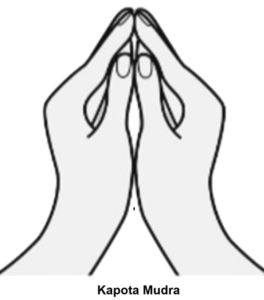Kapota Mudra
Introduction
Kapota Mudra is a sacred hand gesture used in yoga, meditation, and classical dance (Natya Shastra tradition). In Sanskrit, “Kapota” means dove or pigeon, and this mudra is symbolic of humility, reverence, openness, and prayer. It is commonly practiced during meditation, pranayama, and devotional rituals, promoting inner peace, receptivity, and surrender.
In Hasta Mudras, Kapota is also listed in Asamyukta Hastas (single-hand gestures) for dance expression.
Meaning
Kapota = Dove/Pigeon, which is traditionally a symbol of peace, humility, and devotion.
The gesture resembles palms pressed together but slightly cupped, as if creating a hollow space between them—symbolizing openness and receptivity to divine grace.
Represents respect, greeting, prayer, and acceptance in yogic and spiritual practice.
How to Perform (Method of Practice)
Step-by-Step:
Sit in a comfortable meditative posture (Sukhasana, Vajrasana, or Padmasana).
Bring your palms together in Anjali Mudra (prayer gesture).
Keep the base of the palms, fingertips, and edges of the hands touching.
Create a hollow space between the palms, as if holding a delicate dove inside.
Place the hands at the heart center (Anahata Chakra).
Close the eyes, breathe deeply, and focus on humility, peace, and surrender.
Benefits
Physical Benefits
Relaxes the shoulders, arms, and chest muscles.
Improves blood circulation in the hands and heart area.
Helps in deepening breathing when combined with pranayama.
Mental & Emotional Benefits
Cultivates peace, humility, and surrender.
Reduces stress, anxiety, and restlessness.
Encourages openness and receptivity in communication.
Spiritual Benefits
Strengthens connection with the heart center (Anahata Chakra).
Enhances meditation, prayer, and devotion.
Promotes inner harmony and divine alignment.
Contraindications
Avoid if you have severe wrist, palm, or finger injuries.
Should be practiced gently if suffering from arthritis or carpal tunnel syndrome.
Not advised in situations requiring strong grounding (instead use Prithvi Mudra).
Anatomy & Physiology
Involves gentle flexion of finger joints with palm contact.
Creates a hollow space that influences the flow of prana around the heart and chest region.
Stimulates parasympathetic activity, lowering heart rate and promoting calmness.
Kinesiology
Thumbs and fingertips pressing lightly = activation of flexor muscles of the hand.
Palm hollowing = requires coordinated contraction of intrinsic hand muscles.
Shoulder and chest remain open, supporting proper posture.
Neurology
Stimulates median and ulnar nerves of the hand.
Activates the somatosensory cortex for hand awareness.
Promotes parasympathetic dominance, calming the nervous system.
Enhances limbic system activity, improving emotional regulation.
Duration of Practice
General practice: 5–15 minutes.
Meditation/Pranayama: 15–30 minutes.
Can be practiced anytime, especially before meditation, prayer, or when seeking calmness.
Counter Mudra
Anjali Mudra – if stronger devotion and greeting energy is desired.
Hridaya Mudra – to relieve emotional heaviness or grief.
Chin Mudra – to balance inward focus with awareness.
Conclusion
Kapota Mudra is a gesture of humility, reverence, and peace, symbolizing the offering of oneself to the higher self or divine. It harmonizes the mind, body, and spirit, centering energy at the heart chakra. Practicing this mudra enhances devotion, meditation, and emotional balance, making it an essential mudra for both spiritual seekers and practitioners of yoga.
FAQ
Q1: How is Kapota Mudra different from Anjali Mudra?
Kapota has a hollow space between palms, symbolizing openness; Anjali has palms completely pressed together.
Q2: Can it help in stress relief?
Yes, it calms the nervous system and reduces emotional tension.
Q3: Is Kapota Mudra used in dance also?
Yes, in Bharatanatyam and other forms it depicts respect, prayer, and devotion.
Q4: Can beginners practice it?
Yes, it is very simple and safe for everyone.
Q5: Which chakra does Kapota Mudra activate?
It primarily activates the Anahata (Heart Chakra).
References
Bharata – Natya Shastra.
Nandikeshvara – Abhinaya Darpana.
Swami Satyananda Saraswati – Asana, Pranayama, Mudra, Bandha.
Gertrud Hirschi – Mudras: Yoga in Your Hands.
Vasant Lad – The Science of Self-Healing.

